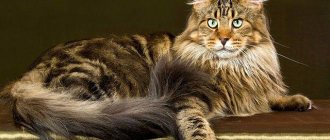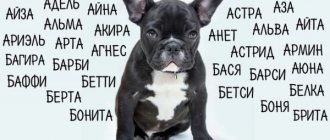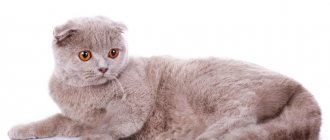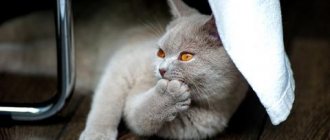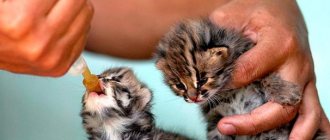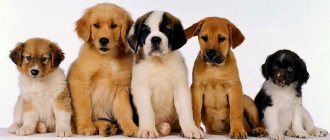What to name a boy raccoon
People love to give names to their four-legged charges, because choosing a nickname for a pet is an interesting and exciting thing.
As a rule, the nickname reflects the appearance, character or habits of the animal, and raccoons are no exception in this regard. What are the main criteria for choosing a nickname for a raccoon? • Firstly, everyone is well aware of the basic habit of raccoons, for which they received their nickname “ gargle ” - rinsing in water any object that gets into their paws. In this case, the raccoon can be given the following nicknames: Clean, Dosya, Mister Proper, and so on.
• Secondly, raccoons are famous for their partial attitude towards food . Moreover, with equal pleasure they will eat treats both offered by the owner and appropriated in another way, for example, stolen from the table or taken from a trash can. The following nicknames are suitable for such gourmets: Apricot, Marshmallow, Obzhorka, Pepper, Cupcake, Snickers and others.
• Raccoons are also known as real bullies . Inspecting the contents of a trash can or hiding the owner’s mobile phone in a “safe place” are their favorite pastimes. Nicknames suitable for such pets are: Skoda, Naughty, Loki, Fraer, Hitryuga, Customs, Egoza and so on.
• By nature, raccoons
are not aggressive animals .
But in apartment living conditions they may experience attacks of aggression. Most often, raccoons demonstrate the most negative aspects of their character during the rutting season or when other animals are introduced into their neighborhood. Animals with such a temper can be called: Angry, Grizzly, Buka, Rambo, Shaitan, Buyan, Kusaka and so on. • If, on the contrary, your favorite has an incredibly friendly and accommodating character , then soft and gentle names will suit him (her): Sweetheart, Freckle, Darling, Bunny, Ogonyok, Angel and others.
• You can also choose a nickname for a raccoon based on its external characteristics . The dark “mask” around the animal’s eyes attracts attention. Call your pet Mr. X, or maybe you like the long and fluffy fur of a raccoon, then you should think about the name Fluffy. The following nicknames are also suitable for the raccoon: Striped Man, Handsome, Milakha, Tuchka and so on.
• And finally, you can choose a nickname for the animal in honor of your favorite fairy tale or cartoon characters (for example, the famous Tiny Raccoon), as well as based on your own hobbies. Are you an avid car enthusiast? Why not name your pet one of your favorite car brands.
Thus, you can find a huge number of options for nicknames for your favorite creature, the main thing is that you enjoy pronouncing it, and your four-legged ward responds to it.
What to name a boy raccoon
Recently, cute raccoons have become increasingly common as pets. They are very funny, cheerful and you can watch them for a long time. If a raccoon settles in your house, you can be sure that you will not be bored; you will never get bored with him. Fluffy and striped pets can give a lot of positive emotions. What to name the boy raccoon who has become a new member of your family? There is no need to choose the first nickname you come across; this issue should be approached carefully.
Nicknames for celebrities
The names and nicknames of many famous people (especially foreign ones) are pleasant to the ear and can be suitable as nicknames, including for cats. If the pet owner has an idol, then this is a good reason to become a little closer to him by naming the pet the same.
Nicknames for cats based on the names of popular people:
- Arnold;
- Benjamin;
- Bismarck;
- Voltaire;
- Newton;
- Magellan;
- King;
- Mao;
- Roosevelt;
- Picasso;
- Einstein;
- Churchill;
- Gandhi;
- Sigmund;
- Nietzsche.
This list can be continued endlessly. But the choice of the most beautiful nickname for his cat can only be made by his owner, based on his preferences and, possibly, on the external or internal similarity of the pet (indirectly, of course) with the chosen person.
© shutterstock
Raccoon Boy Names
Most often, people choose more traditional names for their pets and don’t even think about any interesting nicknames. In fact, choosing the right name for your pet is a very interesting activity.
Usually the nickname reflects the characteristics of the animal. They can be external, they can also be some character traits, behavioral habits. Raccoons are no exception, let's look at what criteria you can use to choose an unusual and interesting nickname:
- Initially, it is worth talking about the love of these animals to wash everything in water or rinse. They rinse absolutely any object that falls into their paws in water, if there is water nearby. Based on this feature, you can choose something like the following: Neat, Tide, Mister Proper and something similar.
- These animals are very fond of any treats. They are real gluttons and are ready to eat literally everything edible that they can find. Be prepared for the fact that they will eat not only what you offer them, but also what they can steal from your table or from the trash can in the house. In connection with this feature, you can choose one of the following: Bagel, Apricot, Marshmallow, Glutton, Coconut, chocolate, Raisin and so on.
- Did you know that raccoons are real hooligans and robbers? Be prepared that if you leave your phone in a visible place, you will not be able to find it there later, since the animal can hide it in a secluded place. This means that based on this feature you can also choose an interesting name for your pet. You can consider the following options: Shkodik, Hitryuga, Inspector, Fraer, Customs and other nicknames of this kind.
- If your pet has a bad character, you can pick him up one of the following: Angry, Grizzly, Biter.
- For a pet with a kind and easy-going character, you can choose one of the following: Cutie, Angel, Kitty, Ogonyok.
- Having decided to build on the appearance of the animal, you can choose an interesting option, for example, Cloud, Striped.
As you can see, there are a lot of unusual and interesting options, so you shouldn’t choose a banal name for your pet. There are a lot of options, but it is important to make your choice based on the pet’s habits, only in this case the name will suit him.
Choosing a name for a cat based on its character
It is not necessary to give your cat a nickname the first time you meet him. After waiting a few days, you can get to know your pet better, determine its character and habits. Then choosing a beautiful nickname will be a little easier, perhaps it will come to the owner’s mind.
Russian nicknames for active pets:
- Ataman;
- Baron;
- Brawler;
- Turn;
- Thunder;
- Daemon;
- Pirate;
- Tyrant;
- Shock.
Beautiful nicknames for boys cats with a calm character:
- Boss;
- Marquis;
- Mister;
- Modest;
- Prince;
- Sultan;
- Tikhon;
- Pharaoh;
- Dandy.
© shutterstock
In addition to temperament, there are many criteria for choosing a suitable original nickname. These could be addictions to certain foods, favorite toys, interesting habits, and more. For example, if a cat likes to listen to music, you can call him a music lover or by the name of a performer . For a lazy cat, you can choose the nickname Lazy or Dream. Any feature can be a reason to get creative.
However, when choosing according to temperament, sometimes it will be interesting to come up with a name in reverse.
If you call a cat that is too quiet and calm Buran, this may make him a little more active. And to a robber who destroys everything around him, the nickname Marquis will give him solidity and calm his lively temper a little. It is not without reason that they say that a name makes significant changes in character, and not only in people, but also in animals.
What not to call a raccoon
- You should not give your pet the name of a previous pet that died. This is a bad omen that can have a detrimental effect on the life of a new animal.
- Names that are overly difficult to pronounce. Such a nickname will not be easy for the owner to pronounce, and it will be very difficult for the baby raccoon to remember it.
- Abstruse terms that will sound stupid and inappropriate apply to these cute and simple animals.
It must be remembered that you can find an incredible variety of nicknames for your favorite creature, the main thing is that the owner feels comfortable and pleasant in calling this nickname, and the four-legged pet quickly responds to it.
Most often, in professional specialized nurseries for breeding raccoons, these animals are christened with rather complex and long nicknames. Such a name usually includes a mention of any predecessors of the animal or information about its pedigree. After the animal gets a home, the easiest way for the owner is to come up with a light and pleasant nickname for it, and leave the name from the nursery as a memorable entry in the animal’s passport.
- What to feed a raccoon at home?
- Tame raccoon
- Raccoon cage
- How to get a raccoon at home?
How to choose a beautiful nickname for your pet
It is believed that the name for a cat of any breed must contain hissing sounds, such as “k”, “s”, “sh”. But this only helps the kitten get used to it faster. It’s good if the nickname is short, consisting of 2–3 syllables.
If you still choose a long one, you can come up with an abbreviation to make it easier for your pet to remember it.
Of course, not everyone names a cat according to the rules. And at the same time, over time, the animal still adapts and begins to respond.
You can choose a beautiful nickname for a kitten based on different criteria:
- in accordance with the external characteristics of the cat;
- by his character;
- by food preferences;
- according to the personal interests of the owner;
- by behavior and any other factors.
The peculiarity of a particular cat may be a loud voice, an interesting color, for example, like a tiger or a leopard, a very calm or, conversely, overly energetic disposition, etc.
Any of these differences from other pets can serve as an excellent criterion when choosing.
Raccoon Habits: Everything You Need to Know
Alas, it is difficult to call such a pet a pleasant and non-conflict neighbor. By nature, the animal has an instinct to constantly search for food. And even if your raccoon has just had a hearty lunch, he will not give up the habit of exploring every corner of the apartment in search of food. At the same time, the raccoon will want to hold each item, including your personal belongings, in its paws, taste it, and ideally, rinse it in a bowl of water and hide it until better times (what if it comes in handy?).
Mischievous raccoons are distinguished by a special mindset: they are cunning and resourceful. As soon as they adapt to a new place, they can pick any locks, open drawers and shelves without any problems. On the priority list: regular checks of the refrigerator, trash can and endless raids into the bathroom.
In order for a raccoon to comply with the rules of the community, it must be raised, while devoting quite a lot of time to the pet. Are you ready for constant care and control of your furry pet? This means you can buy a raccoon and be sure that your boring life will come to an end.
Setting up a place for a raccoon
As we have already said, raccoons are very economic animals. They just need to constantly rearrange things from place to place. It is impossible to wean your pet from this habit, so the best solution would be to allocate personal space for your pet. But the cage is not suitable for this purpose. Raccoons are such restless creatures that they will feel very unhappy in captivity.
A small closet, perhaps a pantry, is suitable for this purpose. The ideal option is an isolated room.
All breakable and fragile items must be removed from the premises. You should hang shelves on the walls or build something like a labyrinth for your pet. Find old things that your pet won’t mind giving away, put them in a basket or just scatter them around the room - the raccoon will find a use for them. And of course, don’t forget to put a bowl of water on the floor. Now your pet will feel at ease.
Raccoon Care
The animal takes care of its luxurious coat on its own. If you suddenly notice an unpleasant odor from your pet, you can give it a bath. But this should be done no more than once every six months. You need to bathe a raccoon using a special shampoo. Prepare yourself for the fact that your pet will not like these manipulations very much.
Raccoons are usually very friendly and sociable. The animals easily get used to people and quickly make contact. But with the achievement of sexual maturity, the character of the stripers can seriously change. Playfulness and mischief turns into aggression. It is impossible to change the situation - nature takes its toll. So, when purchasing a raccoon, be prepared for surprises and surprises, perhaps not very pleasant ones. However, it is simply impossible not to love these animals. Raccoons are charming and charismatic. The main thing is to create the most comfortable conditions for them, and then your friendship will be strong!
Due to various circumstances, animals appear in people's homes. Some people prefer proven options and get cats, dogs and parrots. But it also happens that a wild animal (albeit a very cute one) becomes a neighbor in the living space, which is difficult to teach and train. In this case, it is necessary to learn as much as possible about your neighbor in order to know their habits, preferences and character. Fans of exotic pets or lovers of forest walks have a question about whether it is possible to domesticate a raccoon and whether it can be trained.
What you need to know about raccoons?
The attractive appearance of this funny animal and its apparent goodwill can be misleading. First of all, a raccoon is a wild animal that is not used to contact with people. When buying it, you must have enough living space to create the proper conditions for the animal. A raccoon cannot walk around the house freely; it must have its own corner. In order for a tamed animal to live comfortably, it is necessary:
- Make an enclosure for walking and relaxing;
- Be prepared for night vigil, when the raccoon's main activity begins;
- Immediately accustom the animal to the tray, although the habit of marking territory will remain.
When taming an animal, you must bear responsibility for it. If a person suffers from allergies, has small children, or is afraid of scratches and bites, then it is better not to get a pet that lives at home for up to 20 years.
See also: Interesting facts about raccoons.
What should you do to tame a raccoon?
Once the purchase has already been made, people begin to wonder whether it is possible to tame a raccoon. Experts say that it is quite difficult to domesticate an adult wild animal. It's easier to deal with domestic puppies. If the raccoon is very small, it will require constant care.
- He must be bottle fed;
- Make sure he doesn't get sick.
- Do massages (the video below shows one of the massage options);
Taming can go two different ways. In the first case, the raccoon will be a homebody, and in the second, it will become a traveling companion for its owner.
In an apartment, an animal that will not go for walks needs to make an enclosure, equipping it with stairs, passages, a place to sleep, eat and toilet. This requires a lot of space. Most often, the raccoon occupies an entire room, from which all dangerous objects must be removed. Fluffy Skoda loves to do something unattended.
When raising a traveling raccoon, the owner must accustom it to moving, carrying, and large numbers of people.
Ways to tame a raccoon
If the animal is already quite large, then it must be accustomed to itself gradually. It will be afraid to come close, but contact is necessary in order to feed. The owners need to accustom the raccoon to their presence and feed it only by hand. It is best to sit directly next to the cage and give food as needed. If you don’t pay attention to the raccoon for a long time, it begins to touch its owner with its paw and beg for a tidbit. When the animal adapts, you can start feeding it in the cage, gradually moving closer to the cup.
You can go for a walk with your pet. After all vaccinations have been given, you can purchase a collar and leash and go for a walk on your own. You can go on long journeys only if you have a carrier. The animal may get nervous when there are a lot of people or simply get tired.
At an early age, raccoons are susceptible to various diseases, so they must be carried in your arms at least twice a day, an hour after eating.
Character traits and diet
The raccoon expresses nervousness or dissatisfaction by constantly running around. He can move from one corner of the cell to another without stopping. Only patience and desire will help you establish contact with your pet. If he doesn’t like something, the owner can get a couple of bites and a dozen deep scratches.
The raccoon can be called an omnivore. His diet must include foods such as
- Lean meat, pre-cooked;
- Boiled fish and seafood;
- All fruits except citrus fruits;
- Fresh and boiled vegetables;
- Different types of berries.
You can learn about your pet's preferences only if you are constantly with him and give him due attention.
See also: Reports on frequently asked questions about raccoons.
Whether raccoons learn quickly or whether it will take a long time depends only on the owner. The animal is very good at feeling fear, nervousness and other mood swings. It reacts sensitively to all manifestations and can also respond to aggression. To avoid bites and scratches, you should leave the negative outside the door of the room.
nicknames for raccoons
Fiction for reading and storytelling to children from 1 to 2 years old
Russian folklore
Russian folk songs, nursery rhymes.
+ “Okay, okay!”, “Cockerel, cockerel...”, “Big legs...”, “Water, water...”, “Bay-bye, bye-bye...”, “Pussy, pussy, pussy, scat!.. ", "Like our cat...", "The cat went under the bridge...".
Russian folk tales
- + “Chicken Ryaba”, “Turnip” (model by K. Ushinsky);
- “How a goat built a hut” (model by M. Bulatov).
Works of poets and writers of Russia
Poetry
- + 3. Alexandrova. "Hide and Seek";
- + A. Barto. “Bull”, “Ball”, “Elephant” (from the “Toys” series);
- + V. Berestov. "Hen with Chicks";
- V. Zhukovsky. "Bird";
- + G. Lagzdyn. “Bunny, bunny, dance!”;
- + S. Marshak. “Elephant”, “Tiger Cub”, “Owls” (from the series “Children in a Cage”);
- + I. Tokmakova. "Bainki."
Prose
- T. Alexandrova. “Piggy and Chushka” (abbr.);
- L. Panteleev. “How a pig learned to speak”;
- + V. Suteev. "Chicken and Duckling";
- E. Charushin. “Chicken” (from the series “Big and Small”);
- K. Chukovsky. "Chick".
Fiction for reading to children from 2 to 3 years old
Russian folklore
+ Songs, nursery rhymes, chants
. “Our Masha is small...”; “Our ducks in the morning...”; “The cat went to Torzhok...”; “Chicks, chicks, chicks...”; “Sunny, bucket...”; “Oh doo-doo, doo-doo, doo-doo! A raven sits on an oak tree"; “Because of the forest, because of the mountains...”; “Cucumber, cucumber!..”; “Egorka the Hare...”; “A fox was running through the forest with a little box...”
Fairy tales
- + “Kids and the Wolf”, arr. K. Ushinsky;
- + “Teremok”, “Masha and the Bear”, arr. M. Bulatova.
Folklore of the peoples of the world
- "Three Merry Brothers", trans. with him. L. Yakhnina;
- + “Kotausi and Mausi”, English, arr. K. Chukovsky;
- “Boo-boo, I'm horned”, lit. arr. Yu. Grigorieva;
- “Slide, slide, slide”, Belarusian, arr. L. Eliseeva;
- + “Oh, you little darling…”, “You little dog, don’t bark…”, Mold., trans. I. Tokmakova.
Works of poets and writers of Russia
Poetry
- A. Pushkin. “The wind walks across the sea...” (from “The Tale of Tsar Saltan...”);
- M. Lermontov. “Sleep, baby...” (from the poem “Cossack Lullaby”);
- + 3. Alexandrova. "Hide and Seek";
- + A. Barto. “Bear”, “Elephant”, “Horse”, “Boat”, “Truck” (from the “Toys” series);
- A. Barto. “Who shouts how”;
- + A. Barto, P. Barto. "Roarer Girl";
- + V. Berestov. “Sick Doll”, “Kitten”;
- A. Vvedensky. “Mouse”, “The Driver’s Song”;
- B. Zakhoder. "Hedgehog";
- + G. Lagzdyn. “Cockerel”, “Bunny, bunny, dance!”;
- + S. Marshak. "The Tale of a Stupid Mouse";
- E. Moshkovskaya. “Order” (abbr.);
- N. Pikuleva. “Fox tail...”, “The cat inflated the balloon...”;
- N. Sakonskaya. “Where is my finger?”;
- G. Sapgir. "Cat";
- +/- K. Chukovsky. "Confusion", "Fedotka".
Prose
- +/- L. Tolstoy. “Three Bears”, “A cat slept on the roof...”, “Petya and Misha had a horse...”;
- + V. Bianchi. "The Fox and the Mouse";
- N. Pavlova. "Strawberry";
- + V. Suteev. “Who said meow?”
Works of poets and writers from different countries
- D. Bisset. "Ha-ha-ha!", trans. from English N. Shereshevskaya;
- P. Voronko. "New clothes", trans. from Ukrainian S. Marshak;
- S. Kaputikyan. “Masha is having lunch”, “Everyone is sleeping”, trans. from Armenian T. Spendiarova.
Fiction for reading to children from 3 to 4 years old
Russian folklore
Songs, nursery rhymes, chants.
“Finger-boy...”, “Like our cat...”, “Ant-grass...”, “A squirrel is sitting on a cart...”, “Ai, kachi-kachi-kachi!..”, “Rain, rain, more... ", "Zainka, dance...", "Chi-ki-chiki-chikalochki...", "The night has come...", "Magpie, magpie...", "I'm on my way to grandma, to grandpa...", "Rainbow-arc... ", "Ladybug...", "There are three chickens on the street...", "Tili-bom! Tili-bom!..”, “Shadow, shadow, sweating...”, “Little hen...”, “Little kitten...”, “We lived with grandma...”, “Zarya-zaryanitsa.”
Fairy tales.
- "Kolobok", arr. K. Ushinsky;
- “The Wolf and the Little Goats”, arr. A. N. Tolstoy;
- "Teremok", arr. E. Charushina;
- “Cat, rooster and fox”, arr. M. Bogolyubskoy;
- “Geese-swans”, “Goby - black barrel, white hooves”, “Snow Maiden and the Fox”, arr. M. Bulatova;
- "The Fox and the Hare", arr. V. Dahl; “Fear has big eyes”, arr. M. Serova.
Folklore of the peoples of the world
Songs
- “Little Fairies”, “Question and Answer”, “The Ship”, “The Brave Men”, “The Three Trappers”, English, arr. S. Marshak;
- “What's that noise?”, Latvian, trans. S. Marshak;
- “Two beans, three beans”, lit. lane E. Yudina;
- “Dance, my doll”, Norwegian, trans. Yu. Vronsky;
- “Shoemaker”, Polish, arr. B. Zakhodera;
- “Conversation of Frogs”, “The Uncooperative Hoopoe”, Czech., trans. S. Marshak;
- “Buy onions...”, scot., trans. I. Tokmakova.
Fairy tales
- “Pykh”, Belarusian, arr. N. Myalika;
- “The brave fellow”, Bulgarian, trans. L. Gribova;
- “Two Greedy Little Bears”, Hungarian, arr. A. Krasnov and V. Vazhdaev;
- “Forest Bear and the naughty Mouse”, Latvian, arr. Y. Vanaga, per. L. Voronkova;
- "The Pig and the Kite", a fairy tale of the peoples of Mozambique, trans. from Portugal Yu. Chubkova;
- “Visiting the Sun”, Slovak, trans. S. Mogilevskaya and L. Zorina;
- “Stubborn goats”, Uzbek, arr. Sh. Sagdully;
- “Goat-dereza”, “Mitten”, Ukrainian, arr. E. Blaginina;
- “Nanny Fox”, Finnish, translated by E. Soini,
- "The Rooster and the Fox", Scottish, trans. M. Klyagina-Kondratieva.
Works of poets and writers of Russia
Poetry
- K. Balmont. "Mosquitoes-makariki";
- A. Blok. "Bunny";
- S. Gorodetsky. “Wind Lullaby”, “Who is it?”;
- A. Koltsov. “The winds are blowing...” (from the poem “Russian Song”);
- I. Kosyakov. "She's All";
- A. Maikov. “Lullaby”, “The Swallow Has Rushed...” (from modern Greek songs);
- L. Modzalevsky. "Butterfly";
- A. Pleshcheev. “Autumn has come...”, “Rural Song”, “Spring” (abbr.);
- A. Pushkin. “Our light, sunshine!..”, “Month, month...”, “Wind, wind!..” (from “The Tale of the Dead Princess and the Seven Knights”);
- A.K. Tolstoy. “My bells...” (excerpt);
- S. Cherny. “Concert”, “The Calf Sucks”, “The Bailiff”, “About Katyusha”.
- 3.Alexandrova. "Rabbits", "Bathing";
- A. Barto, P. Barto. “Greasy girl”;
- V. Berestov. “Hen with Chicks”, “Bull”, “Cockerels”;
- G. Galina. “The Dwarf and the Squirrel”, “Song of the Mice”;
- N. Zabolotsky. “How the mice fought with the cat”;
- B. Zakhoder. “Builders”, “Chauffeur”, “Tailor”;
- V. Kataev, “Hedgehog”;
- A. Krestinsky, N. Polyakova. "Enchanted Girl";
- A. Kushner. “Who broke the big vase?”;
- S. Marshak. “Zoo”, “Giraffe”, “Zebras”, “Polar bears”, “Ostrich”, “Penguin”, “Swan”, “Camel”, “Eskimo dog”, “Monkey”, “Where did the sparrow have dinner?” (from the series “Children in a Cage”), “The Tale of a Smart Mouse”, “A Quiet Tale”;
- V. Mayakovsky. “What is good and what is bad?”, “Every page is either an elephant or a lioness”;
- S. Mikhalkov. "Song of Friends";
- E. Moshkovskaya. “Mitya - myself”, “I will not be afraid!”, “Greedy”;
- R. Sef. “Everything in the world is similar to everything...”;
- I. Tokmakova. “Where the Fish Sleeps”, “Bear”, “Ten Birds - a Flock”;
- E. Uspensky. “Once upon a time there was a little elephant”;
- D. Kharms, N. Radlov. “Stories in pictures”: “Stubborn goats”, “Where are the children?”, “Good duck”, “Wouldn’t you swing ...”, “Where is the ball?”;
- E. Charushin, E. Shumskaya. "Coward", "Horse";
- K. Chukovsky. “Confusion”, “Miracle Tree”, “Taping Fly”. “Moidodyr”, “Joy”, “Stolen Sun”, “Hedgehogs Laugh”, “Aibolit”, “Turtle”, “Christmas Tree”.
Prose
- V. Dahl. "Crow";
- D. Mamin-Sibiryak. “The parable of Milk, Oatmeal Porridge and the gray cat Murka”, “The Tale of the Brave Hare - Long ears, slanting eyes, short tail”;
- L. Tolstoy. “The bird made a nest...”, “Tanya knew the letters...”, “Varya had a siskin...”, “Spring has come...”;
- K. Ushinsky. “Vaska”, “Fox Patrikeevna”, “Cockerel with his family”, “Ducks”, “Wind and Sun”.
- T. Alexandrova. “Animal”, “Burik the Bear”;
- G. Ball. “Newbie on a Walk”, “Yellow Boy”;
- V. Bianchi. “Bathing bear cubs”, “Bear-head”;
- L. Voronkova. “Masha the Confused”, “It’s Snowing” (from the book “It’s Snowing”;
- Yu. Dmitriev. “Blue Hut”, “Who Flies Without Wings”;
- B. Zhitkov “How we went to the zoo”, “How we arrived at the zoo”, “3ebra”, “Elephants”, “How the elephant bathed” (from the book “What I saw”);
- M. Zoshchenko “Smart Bird”;
- N. Nosov. "Steps";
- L. Petrushevskaya. “Peter the Pig and the Car”, “Peter the Pig and the Store”;
- E. Permyak. “How Masha became big”;
- M. Prishvin. “Woodpecker”, “Leaf Fall”;
- S. Prokofiev. “Masha and Oika”, “When you can cry”, “The Tale of the rude word “go away””, “The Tale of an ill-mannered mouse” (from the book “Fairy Tale Machines”);
- N. Romanova. "Smart Crow";
- V. Suteev. "Three kittens";
- A. N. Tolstoy. “Hedgehog”, “Fox”, “Cockerels”;
- D. Harms. "Brave Hedgehog";
- G. Tsyferov. “About an eccentric frog” (first tale, third tale), “When there are not enough toys” (from the book “About the chicken, the sun and the bear”);
- E. Charushin. “Duck with Ducklings”, “Bear and Bear Cubs” (from the series “Big and Small”);
- K. Chukovsky. “So and not so.”
Works of poets and writers from different countries
Poetry
- Ya. Baltvilks. "Rhyme with answers", trans. from Latvian D. Tseselchuk;
- A. Bosev. "Rain", trans. from Bulgarian I. Maznina, “Three”, trans. from Bulgarian V. Viktorova, “The Chaffinch Sings,” trans. from Bulgarian I. Tokmakova;
- G. Vieru. "The Hedgehog and the Drum", trans. with mold. Y. Akima;
- P. Voronko. "The Sly Hedgehog", trans. from Ukrainian S. Marshak;
- N. Scored. "Pencil", trans. from Ukrainian 3. Alexandrova;
- S. Kaputikyan. “Who will finish drinking sooner?”, “Masha doesn’t cry”, trans. from Armenian T. Spendiarova;
- M. Karem. "My cat", trans. from French M. Kudinova;
- L. Mileva. "Swift Legs and Gray Clothes", trans. from Bulgarian M. Marinova;
- A. Milne. "Three Little Foxes", trans. from English N. Slepakova.
Prose
- O. Alfaro. "Hero Goat", trans. from Spanish T. Davityants;
- E. Bekhlerova. "Cabbage Leaf", trans. from Polish G. Lukina;
- D. Bisset. "The Frog in the Mirror", trans. from English N. Shereshevskaya;
- A. Karaliychev. "The Little Duckling", trans. from Bulgarian M. Kachaunova;
- L. Muur. "Little Raccoon and the One Who Sits in the Pond", trans. from English O. Obraztsova;
- O. Panku-Yash. "Good night, Dooku!", trans. from room M. Olsufieva,
- “Not only in kindergarten” (abbr.), trans. from room T. Ivanova;
- B. Potter. "Ukhti-Tukhti", trans. from English O. Obraztsova;
- I. Chapek. “A Hard Day”, “In the Forest”, “Yarinka’s Doll” (from the book “The Adventures of a Dog and a Cat”), trans. from Czech G. Lukina;
- Ch. Yancharsky. “In the Toy Store”, “Friends”, “Games”, “Scooter” (from the book “The Adventures of Mishka Ushastik”), trans. from Polish V. Prikhodko.
For learning by heart
- “Cockerel, cockerel...”, “Like our cat...”, “Cucumber, cucumber...”, “There are three hens on the street...”, Russian. adv. songs; A. Pushkin. “The wind walks across the sea...” (from “The Tale of Tsar Saltan...”); S. Cherny.
- "Attachment"; K. Chukovsky. “Christmas tree” (abbr.); A. Barto. “Bear”, “Boat”; V. Berestov.
- "Cockerels"; E. Ilyina. “Our Christmas tree” (abbr.); N. Pikuleva. “The cat was inflating the balloon”; N. Sakonskaya. “Where is my finger?”
And also
Domestic authors: V. Suteev “Fairy Tales and Pictures” is a book that has been around for many, many years. T. Kryukova “Little Hedgehog”, “Little Kangaroo Rooney”, “Little Engine Puff”, “Little Beep”, “Dinosaur is Looking for Mom” - good educational books by the famous children’s writer. A. Ivanov “About Khoma and Suslik.” V. Chizhikov “Peter and Potap the Bear” - easy, understandable text, bright, lively pictures, what else is needed to make 2-3-year-olds glow with delight? A. Usachev “Smart Dog Sonya”, “About Baba Yaga”, etc. Usachev is one of the most popular authors in Russian children's literature, very inventive and talented. M. Plyatskovsky “Daisies in January”, “Diary of the Grasshopper Kuzi” and other fairy tales, poems and songs - very kind and sincere. G. Oster “A Kitten Named Woof”, “Bad Advice”, “38 Parrots”, “The Adventures of Pif”. Several generations have already grown up on fairy tales, poems, and cartoons by Grigory Oster. G. Tsyferov “The Engine from Romashkovo”, “How the Little Frog Was Looking for Dad”, “The Little Giant”, etc. Wonderful fairy tales and wonderful characters. E. Charushin “Tyupa, Tomka and Magpie” - funny stories about animals by V. Bianchi “Fairy tales for little ones.” S. Kozlov “Hedgehog in the Fog”, “Tales about the Hedgehog and the Little Bear”, “Lion Cub and Turtle”. Touching, magical fairy tales, familiar to us from childhood. V. Krotov series about the Worm Ignatius - stories about an extraordinary talking worm who helps his friends understand very important things. S. Sedov “Tales about mothers”, “Tales about kings”. Sedov has very unusual, lively stories. S. Prokofiev “Masha and Oika”, “The Adventures of the Yellow Suitcase”, etc. T. Alexandrov “Kuzka the Brownie”. A. Kurlyandsky “About the parrot Kesha.” V. Postnikov “The Adventures of Pencil and Samodelkin.” E. Pasternak “The Adventures of Toys in an Ordinary Apartment” is a story about toys that come to life and about the little things in the big world that adults no longer notice. K. Ushinsky Stories and fairy tales. Foreign authors: B. Potter “Tressie the Squirrel and His Friends”, “Peter Rabbit and His Friends”, “Johnny Mouse and His Friends”, “Tales of Tabitha the Cat” - charming stories from the life of funny animals with stunning author’s illustrations. J. Harris "The Tales of Uncle Remus." Who doesn't know J. Harris and his Brother Rabbit and Brother Fox? S. McBratney “Do you know how much I love you?” - touching text filled with tenderness and amazing illustrations. E. Karl “The Very Hungry Caterpillar.” A. Preisn “About a kid who could count to ten.” Z. Miler, E. Petishka, G. Doskolova series about Krotik - books based on the popular Czech animated series with Krotik in the title role. V. Bush “Plikh and Plyukh” is a humorous fairy tale in verse translated by D. Kharms. E. Blyton “The famous duckling Tim.” M. Ketchpool “How to Move a Hippopotamus”, A. Stewart “Bunny Ears”, M. Marshall “The Lion Cub is Lost!”, L. Rankin “Ruthie the Fox and the Untruth”, K. Friedman “Blame the Huge Blue Panda!” - witty, cheerful tales with meaning. Great illustrations. V. Thomas and K. Paul - a series about the witch Winnie. Falconer Ian Stories about Olivia the pig - “Olivia”, “Olivia Saves the Circus”, “Olivia and the Lost Toy”, “Olivia and the Real Orchestra”, “Olivia Celebrates the New Year”. F. Matter “The Little Wolf and the Dinosaurs”, “The Little Wolf Celebrates the New Year”. K. Wilson, J. Chapman “When Little Bear wakes up”, “When Little Bear sleeps”, “Bear’s New Friend”, “Bear’s Christmas” - amazing illustrations by J. Chapman and amazingly sweet, kind text by Karma Wilson translated by the poet M. Yasnov. H. Heine “Three from Kukalau”, “It’s good to have friends”, “It happened in Kukalau”, “Secrets of the Kukalau farm” - about the adventures of the rooster Franz, the mouse Johnny and the pig Valdemar. A. McAlister, W. Churchill, C. Fudge “There you are, Wombatic”, “What Wombatic loves.” The wombat is a small Australian animal. He is restless and mischievous, and various adventures happen to him. Wombatic was invented and drawn by Charles Fudge, one of the most popular illustrators in England. S. Nordkvist - a series about old man Penson and his cat Findus. D. Wislander, S. Nordkvist - a series about “the most famous Swedish cow” Mama Moo. J. Donaldson “The Gruffalo”, “The Gruffalo’s Daughter”, “The Snail and the Whale”, “If the House is Crowded”, “Charlie Cook’s Favorite Book” - funny poetic tales. A. Kazalis “Hedgehogs Make Apple Syrup and Other Stories”, “The Village of Ladybugs and Other Stories”, “Tales of Grandmother Rabbit”, “Tales of Grandma Bear” are expensive books, but Tony Wolfe’s beautiful illustrations are worth it. They are ideal for looking at and discussing with your baby. L. Clinting - a series about the kind and smart beaver Castor. N. Moost, A. Rudolf - series about Little Crow. H. Hansen Lev Lars. H. de Beer - a series about the polar bear Barney, who lives in the far North and constantly gets into different stories. K. DiCamillo “Mila Pig. Funny stories". Kate DiCamillo is the author of stories about the mouse Despereaux, the porcelain rabbit Edward, and a mongrel named Winn-Dixie. But this is for older kids. And about Mila the pig, who loves to eat toast with butter and ride in a car - just for kids 3-4 years old. J. Yurie “Full Moon Festival”, “The Sly Fox”, “Hurray, Let's Fly!”, “Merry Carnival”, “Drawing Lesson” - several books about a large rabbit family, with whom incredible stories constantly happen. K. Holabird “Angelina the Ballerina”, “Angelina’s Birthday”, “Angelina in the Palace”, “Angelina is the Star of the Show” - stories about a charming little mouse, magnificent illustrations. D. Bisset Tales. E. Hogarth “Muffin and His Merry Friends” - stories about the donkey Muffin, in which he searches for treasure, bakes pies, sings songs and reflects on the beauty of his tail. A. Milne, B. Zakhoder “Winnie the Pooh and all-all-all.” T. Jansson “Tales of the Moomin Valley” are stories familiar to us from childhood about the strange world of the Moomins, which were drawn by the author herself. A. Balint “Gnome Gnomych and Raisin” - fairy tale stories about Gnome Gnomych and the pig Raisin, you can find a publication with drawings by V. Suteev. D. Urban “All Mice Love Cheese” is a touching story about mouse Romeo and Juliet with a happy ending. R. Munch “At least Something Pretty”, “Stephanie's Ponytail”, “Thomas and the Overalls” - small funny stories from the famous Canadian children's writer with original illustrations. M. Bond - a series about Paddington Bear. O. Preusler “Little Witch”, “Little Ghost”. Annie M.G. Schmidt "Sasha and Masha"
How to name a baby raccoon, how to properly raise and feed it?
- May 21, 2019
- Wild animals
- Miftakhova Anna
Raccoons are incredibly charming and cute animals! They are gaining more and more popularity on the Internet, competing with other pets. Yes, this is a wild animal, but it is so attractive to lovers of exotic things that it skillfully turns into an honorary member of the family. Raccoon raccoons are truly mischievous and very curious by nature. It is not difficult for them to crawl around every crevice of your kitchen in search of a tasty treat, and then hide in a secluded corner and slurp it with pleasure. But do you know the correct name for a baby raccoon? The question is interesting, and today you will find out the name of the babies with black glasses around their eyes and a striped tail. Once you have a raccoon in your home, you will be surprised by its intelligence and cunning habits. They love affection and communication with their owners, so they are able to attract attention to themselves in the most extraordinary way. By the way, they get along well in the same territory with cats and dogs.
Total information
Raccoons belong to the phylum Chordata, the class of mammals, and the order of carnivores. They are representatives of canines from the raccoon family. They are widespread throughout Eurasia, but once arrived from North and Central America. Raccoon raccoons adapt well to a wide variety of climatic conditions and live well in the forests of the Far East. By the way, all cubs, regardless of gender, are called puppies.
These cute animals have five toes on their front paws, which makes them very similar to us. They skillfully use their hands: peel fruit, manipulate various objects and climb trees. Raccoons' feet are quite mobile and allow them to perform all sorts of tricks on tree branches.
Raccoon
Appearance
The height of a medium-sized dog. Body length 45-60 cm, tail 20-25 cm; weight 5-9 kg. The physique is dense, stocky; the paws are short, with toes so developed that the marks resemble the imprint of a human palm. The head is wide with a short pointed muzzle and rounded ears.
Raccoon paws are short, with developed toes
The raccoon's fur is thick and brownish-gray. On the sides of the head it is slightly longer and forms “tanks”. The face has a characteristic mask - black with white trim. There are 5-10 wide black or brown “rings” on the tail.
Spreading
The striped raccoon is distributed in North America, from the Isthmus of Panama to the southern provinces of Canada. His acclimatization was carried out in Germany and Russia; From the release points, the raccoon moved to France and other European countries.
Lifestyle and nutrition
Range of the striped raccoon. The red area is the natural range, the blue areas are the result of human introduction.
Mixed forests with old hollow trees and the presence of ponds or swamps are most suitable for the striped raccoon. He avoids coniferous forests, as well as forests without bodies of water. In the south of its range it is found on the sea coast. Raccoons easily adapt to the anthropogenic landscape, settling on the outskirts of fields, in gardens, and are often found in cities and suburbs. The raccoon makes its home (often several) in hollows, sometimes at a height of 20-30 meters above the ground. As a last resort, he uses ground shelters - crevices in rocks, badger holes; He doesn’t know how to dig holes himself. Leads a twilight-nocturnal lifestyle; spends daytime hours in the den. It goes fishing at dusk, walking around its area (with a radius of up to 1.5 km) in search of food.
The striped raccoon deftly climbs trees; very tenacious fingers allow it to hang, clinging to a horizontal branch, or go down the trunk upside down. Thanks to excellent night vision and vibrissae, bundles of which are located not only on the head, but also near the claws, on the inside of the limbs, on the chest and stomach, the raccoon moves confidently even in complete darkness. Raccoons swim well, although reluctantly.
The only representative of the raccoon family that goes to sleep for the winter. Sleep is shallow and intermittent. In Canada it lasts 4-5 months; in the southern regions the raccoon often does not fall asleep at all. Sometimes up to 10 individuals gather in large hollows for the winter.
The raccoon is omnivorous. Its diet shows a seasonal change in food. In spring and early summer, the basis of its diet is animal feed; in the second half of summer and autumn he prefers plant foods. The raccoon's main animal food is insects and frogs, less commonly reptiles (snakes, lizards), crayfish and crabs, fish, rodents and bird eggs. The plant diet consists of berries, acorns, nuts and fruits. Before eating, the raccoon sometimes rinses the food in water; hence its Russian name “gargle” and the Latin specific name lotor
. If raccoons live near people, they will readily rummage through garbage.
The raccoon is a very resilient animal. It is immune to many infectious and invasive diseases and aggressively defends itself against predators. Raccoons are attacked by coyotes, wolves, bobcats, elks, alligators, owls; on the cubs - snakes. If a raccoon cannot hide or escape, it will play dead. By nature, this animal is active, very curious, pugnacious, brave and cunning. In the United States and many other countries around the world, raccoons are sometimes kept as pets.
Life expectancy is up to 12-16 years, but, as a rule, they live no more than 2-5 years.
Social structure and reproduction
The rut occurs in February-March, pregnancy lasts 63 days. The female brings 3-7 cubs, which mature on the 18-20th day. In August-September, at the age of 4-5 months, young raccoons become independent, but sometimes the brood remains with the mother until winter. Females reach sexual maturity at one year of age.
Economic importance
The striped raccoon is a valuable fur-bearing animal. The meat is edible. The first experiments on its breeding in the USSR were carried out in 1936, in the Caucasus, Central Asia, Belarus and the Far East. The striped raccoon has not taken root in the Primorsky Territory.
In the USA, where the raccoon is not only a commercial species, but also a popular object of sport hunting, it is searched for with a specially baited dog. In North America, raccoons often destroy fields, orchards, vineyards, melon fields and chicken coops, harming farms.
Development
The length of a newborn raccoon puppy is from 12 to 16 cm, and its weight is 50-100 grams. The body is covered with light fluff, and the eyelids are tightly closed. It is almost impossible to artificially feed a baby from the first days, since he is very weak and has fragile health. The stages of development are as follows:
- Age 12 weeks. The eyes open approximately on the 18th day, less often on the 24th. After 20 days, the first teeth erupt. The fur gradually begins to take on the color usual for a raccoon. During this period, you can start feeding the baby milk or puppy formula. The animal's limbs become stronger, allowing it to take its first timid steps. The world around us attracts the baby raccoon with its diversity.
- Age 16 weeks. The baby is quite active and can stand well on all four legs. Now the dairy diet can be completely replaced with special foods. At this age, you need to let the raccoon understand that it should not sleep in its owner's bed.
- Age 20-24 weeks. All the raccoon’s teeth had grown by this time, and the diet had become complete. By the way, in nature, cubs can get food on their own.
- The period of growing up. Sexual heat in males (rut) occurs in the second year of life, and in females (estrus) - at 10-12 months. Wool sheds with the arrival of spring.
Feeding a raccoon puppy
You will have to feed the baby for about 1.5-2 months with diluted cow's milk (whole goat's milk) every two hours. It is very convenient to use a baby bottle with a nipple for this. If a baby raccoon refuses to eat, you should coat the tip with condensed milk.
Upon reaching 1.5 months, we begin to add complementary foods to the baby’s menu, but following a strict rule - no more than one product per day. Allowed products include: mashed banana, soft cottage cheese, quail egg, grated apple and yogurt.
At the age of two months, we introduce lean chicken or turkey into the baby’s diet. After a month, we wean the raccoon off the bottle and begin feeding it from a bowl. By five months, the diet should not differ from that usual for an adult. By the way, the tummy of a baby raccoon needs regular massage to avoid problems with digestion. To do this, just stroke your belly for about 10 minutes.
What is a baby raccoon called?
Choosing a name for a pet is very important, because it should reflect the basic qualities of the animal. By the way, raccoons are called raccoons for a reason; the fact is that they always try to wash what they get into their paws. In this regard, the baby can be called: Tide, Clean, Mister Proper, Gala or Aunt Asya.
What is the name of the baby raccoon that doesn’t mind eating something tasty? By the way, these mischievous people are capable of getting what they want not in the most honest way, so the name can be one of these: Slastena, Peach, Marshmallow, Snickers, Churchkhella, Raisin, Prankster or Cookie.
The choice of nicknames is huge, and it is important to choose one that you like, that is memorable and easy to pronounce. Here are a few more options: Friar, Zlyuka, Shkodnik, Shaitan, Locky, Naughty, Grizzly, Sly, Customs Officer, Egoza, Kusaka, or Brawl. Having decided to have a raccoon at home, you should take responsibility for its upbringing, because, despite all its charm, this is a wild animal from the forest. Now you know the correct name for a baby raccoon and that it is actually a puppy.
Names of famous cats
An interesting and beautiful nickname can be given to a pet by a corresponding character from a cartoon, fairy tale or other work. Appearance can also play a role here if the kitten looks like one of the famous felines.
Beautiful names of famous cats:
- Garfield;
- Basilio;
- Boniface;
- Leopold;
- Simba;
- Felix;
- Gribo;
- Jonesy;
- Sylvester;
- Shere Khan.
In addition to literary heroes, there is a tendency to name cats the same as the names of celebrity pets. Apparently, their imagination is usually well developed, and rare beautiful nicknames are given more easily than to “mere mortals.”
Nicknames of celebrity cats:
- Barry (John Travolta);
- Vinny (Whoopi Goldberg);
- Sox (Bill Clinton);
- Alistair (Dita Von Teese);
- Lewis (Nicolas Cage);
- Gucci (Alexey Chumakov);
- Philosopher (Armen Dzhigarkhanyan);
- Georges (Anastasia Volochkova);
- Schumacher (Victoria Bonya);
- Kasper (Irina Dubtsova).
You can always choose something interesting and memorable for your furry pet.
And it doesn't have to be an already existing name. The lists may prompt the owner to come up with an even brighter and more beautiful option.


